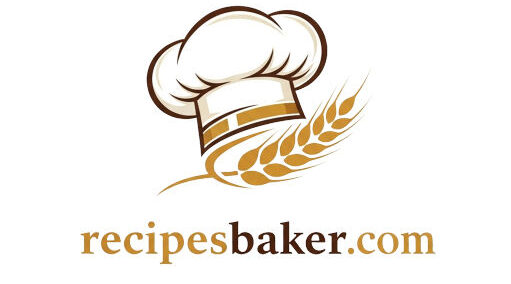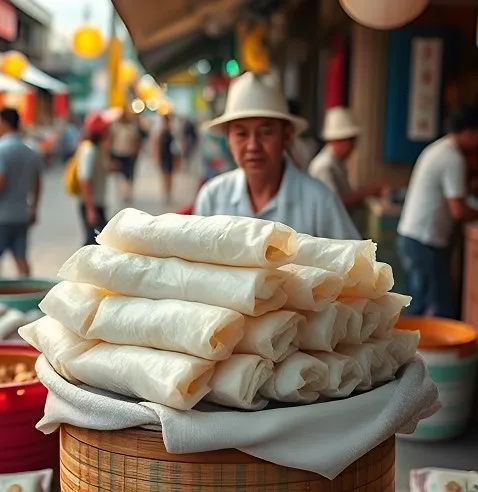If you’ve ever set foot in a bustling Vietnamese street market or enjoyed a quiet breakfast in a family-run eatery in Hanoi, you’ve likely experienced the delicate charm of Banh Cuon. These steamed rice rolls are far more than just a meal—they are an edible ode to Vietnam’s rich culinary history and agricultural heritage. In this article, we’ll embark on an immersive culinary journey, exploring the origins, techniques, cultural significance, and modern twists of banh cuon. By the end, you’ll not only understand what makes these rice rolls uniquely delectable but also feel inspired to recreate them in your own kitchen
The Humble Origins and Cultural Legacy
Banh cuon’s story is intertwined with the history of Vietnam. Originating in the northern regions near Hanoi and famously associated with the Thanh Tri district, these rice rolls were born out of a practical necessity. In a country where rice is a way of life, using rice flour to create a light yet filling meal made perfect sense. What began as a means to transform simple ingredients into nourishing, portable food has turned into a cherished tradition, steeped in local lore and passed down through generations.
The dish’s evolution mirrors Vietnam’s own journey through history. Over time, regional variations emerged that allowed local chefs to experiment with fillings and accompaniments. Despite these variations, the emphasis has always been on simplicity—using readily available, high-quality ingredients to craft something beautifully refined. The process of steaming a thin layer of batter to create translucent, delicate sheets epitomizes the care and skill inherent in Vietnamese culinary art.
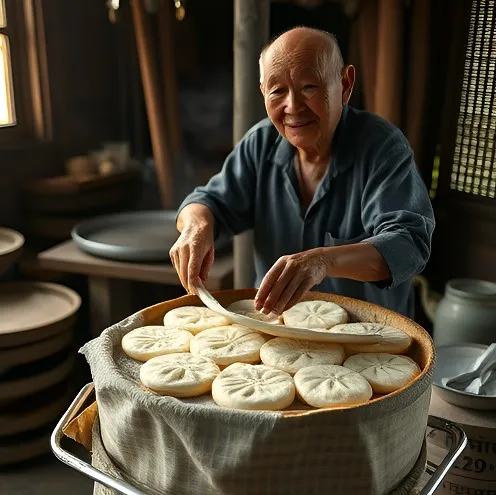
What Exactly Is Banh Cuon?
At its core, banh cuon is a dish featuring incredibly thin, steamed rice sheets that envelop a savory filling. The batter itself is a humble blend of rice flour, tapioca starch, and water, which, when steamed, transforms into a soft, silky canvas perfect for a variety of fillings. Traditionally, the filling is a harmonious mix of ground pork, wood ear mushrooms, and finely chopped shallots, seasoned with a dash of fish sauce and a hint of salt. However, modern interpretations of banh cuon have seen creative adaptations including chicken, shrimp, tofu, or even a medley of vegetables to cater to diverse dietary preferences.
Uniquely versatile, banh cuon is rarely served on its own. It is typically accompanied by an array of garnishes such as fresh herbs (think cilantro, mint, or Thai basil), bean sprouts, and crispy fried shallots. All of these components are meant to be dipped into a signature sauce known as nuoc cham—a tangy, slightly sweet concoction that elevates each bite.
The Art of Crafting the Perfect Rice Roll
Preparing banh cuon is an art that demands patience, precision, and a bit of practice. The process begins with the preparation of the batter. When rice flour and tapioca starch blend seamlessly with water and rest for a period (often around 30 minutes), a smooth, lump-free consistency is achieved. This resting time not only hydrates the starches but also ensures that the eventual rice sheet will possess that coveted translucent quality.
A traditional method involves steaming the batter on a cloth or thin plate over a pot of boiling water. The technique requires a delicate balance—a very thin layer of batter is spread evenly to achieve paper-thin sheets that are soft yet robust enough to hold the filling. For those without a dedicated steamer, a non-stick pan with a tight-fitting lid can work as an effective alternative. The key is to allow the rice sheet to steam gently until the edges begin to lift, signaling its readiness for the next delicate step.
Once the rice sheet is steamed, it’s time to add the filling. A careful spoonful of the prepared mixture—sautéed ground pork, mushrooms, shallots, and garlic—is laid onto the rice sheet, which is then rolled up like a soft spring roll. The finished roll is light, moist, and brimming with an evenly balanced savory-sweet profile that only enhances with the addition of fresh herbs and crisply textured fried shallots.
A Closer Look at the Essential Ingredients
The beauty of banh cuon lies in its straightforward components, each playing a critical role:
Rice Flour and Tapioca Starch
The backbone of banh cuon is its batter, which relies on a carefully measured combination of rice flour and tapioca starch. Rice flour gives the dish its base flavor and smooth texture, while tapioca starch adds elasticity, allowing the roll to be flexible yet resilient.
Ground Pork and Alternative Fillings
Traditionally, ground pork is the star of the filling, offering rich flavor and moisture. However, many chefs have experimented with substitutions. Chicken or shrimp provide lighter, subtly different tastes, while tofu or a medley of finely chopped vegetables can transform the dish into a vegetarian delight that caters to modern health trends.
Wood Ear Mushrooms and Aromatics
Wood ear mushrooms contribute a slight crunch and an earthy undertone that contrasts beautifully with the softness of the rice sheets. Combined with shallots and garlic—sautéed to perfection—the filling achieves a harmonious blend of textures and flavors.
Nuoc Cham – The Quintessential Dipping Sauce
No discussion of banh cuon would be complete without nuoc cham. This dipping sauce, made from fish sauce, fresh lime juice, a touch of sugar, finely minced garlic, and chopped chili, ties all the elements together. It brings a balanced burst of sourness, sweetness, saltiness, and heat to each bite, creating a flavor symphony that is distinctly Vietnamese.
Step-by-Step Guide: Making Banh Cuon at Home
For those inspired to recreate banh cuon in their own kitchen, here’s a detailed guide to help you master this delicate dish:
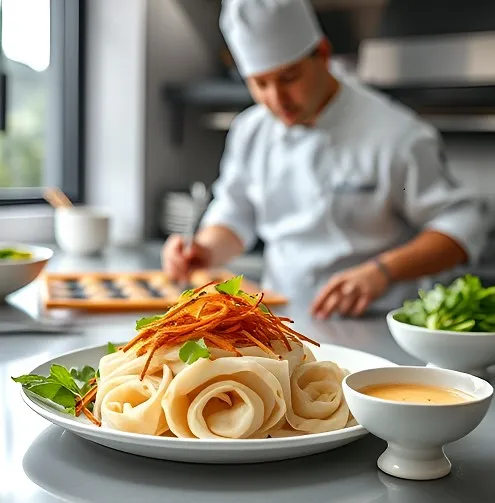
1. Preparing the Batter
Begin by combining rice flour, tapioca starch, and cool water in a mixing bowl. Stir vigorously until the mixture is smooth and free of lumps. Allow the batter to rest for at least 30 minutes. This step is crucial as it enables the flours to fully hydrate, ensuring that your rice sheets develop the proper consistency when steamed.
2. Sautéing the Filling
In a hot pan, add a splash of vegetable oil over medium-high heat. Toss in minced garlic and chopped shallots, allowing them to soften and infuse the oil with their aroma. Next, incorporate the ground pork, breaking it up as it cooks. After a few minutes, add cleaned and chopped wood ear mushrooms. Season with a pinch of salt, ground black pepper, and a few drops of fish sauce. Stir until all the ingredients are well combined and the pork is fully cooked.
3. Steaming the Rice Sheets
If you’re using a traditional steamer, drape a clean, thin cloth over the steaming tray. Pour a thin layer of the rested batter onto the cloth and cover immediately with a lid. Steam for about 30 seconds or until the edges start to lift from the surface. If a steamer isn’t available, a non-stick pan with a lid works well—just ensure you have a way to transfer your delicate sheet without tearing it.
4. Assembling the Rolls
Once the rice sheet is ready, carefully slide it onto a clean plate. Place a spoonful of the savory filling in the center of the sheet. With gentle yet decisive movements, roll the sheet over the filling, much like wrapping a spring roll. Repeat this process until all rice sheets and fillings are used.
5. Final Touches and Presentation
Arrange your roll-ups neatly on a serving plate. Enhance the dish by sprinkling crispy fried shallots over the top and adding a handful of fresh herbs such as cilantro or mint. Serve immediately with a side bowl of nuoc cham, letting your guests dip each bite into the vibrant, tangy sauce.
Regional Twists: Variations Across Vietnam
While the core ingredients and methods remain consistent, national and regional variations of banh cuon highlight the creativity of Vietnamese cuisine. In northern regions, the dish tends to be more understated, emphasizing the natural flavors of the rice and pork without too many embellishments. Here, banh cuon is considered an art form, with chefs striving for perfectly translucent rice sheets and a strictly measured filling.
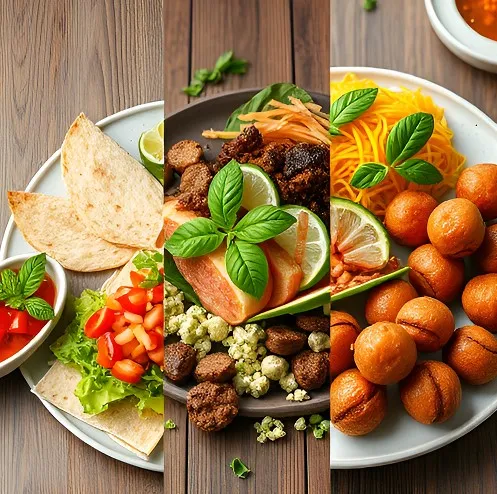
In contrast, southern Vietnam often adopts a bolder approach. With a slightly sweeter nuoc cham and additional toppings—such as shrimp, extra fried shallots, or even a dash of chili oil—the southern variation caters to a taste for vibrant, layered flavors. Central Vietnam, known for its distinctive culinary traditions, sometimes pairs banh cuon with heartier accompaniments like pork organ congee, creating a meal that is both comforting and robust.
These regional idiosyncrasies not only reflect local tastes but also embody the adaptability of banh cuon. Whether you prefer the minimalist approach of the North or the lavish garnishing of the South, every version offers a unique window into the local culinary landscape.
The Health Benefits of Banh Cuon
In today’s age of health-conscious eating, you might wonder whether banh cuon is a healthy choice. The answer is yes—when prepared using quality ingredients, banh cuon can be a light, heart-healthy option. The rice sheets, made from rice flour and tapioca starch, are low in fat and provide a good source of carbohydrates. The lean proteins used in the filling, particularly if you opt for tofu or lean cuts of meat, add nutritional value without an overload of calories.
Additionally, the inclusion of fresh herbs, mushrooms, and a minimal amount of oil during the sautéing process ensures that the dish is balanced and not overly heavy. Paired with the flavorful yet light nuoc cham, banh cuon makes for a satisfying meal that fuels your day without weighing you down.
Nuoc Cham: The Signature Sauce That Ties It All Together
Perhaps the most critical element of a banh cuon meal is nuoc cham. This aromatic dipping sauce is a microcosm of Vietnamese flavor philosophy—it strikes a balance between salty, sweet, sour, and spicy. The typical preparation involves mixing fish sauce, lime juice, sugar, garlic, and chili, though variations abound. Its role is to accentuate the delicate texture of the rice roll while providing a punch of flavor that lingers on the palate.
For many home cooks, perfecting nuoc cham can be just as satisfying as mastering the rice rolls themselves. With each element carefully measured and mixed, the dipping sauce becomes the secret ingredient that transforms a simple dish into an unforgettable culinary experience.
Embracing Tradition in a Modern Kitchen
In a world where culinary boundaries are continually being pushed, banh cuon represents a bridge between time-honored tradition and contemporary innovation. Many modern chefs have found inspiration in this classic dish, reimagining it for the 21st century while still paying homage to its roots. Vegetarian versions featuring tofu and mixed vegetables are gaining popularity, allowing even those who shun meat to enjoy the delicate flavors of banh cuon. Likewise, experimental interpretations may incorporate elements like spicy sriracha drizzles or fusion fillings that include ingredients not traditionally found in Vietnamese cooking.
What remains constant, however, is the commitment to fresh ingredients and a balanced approach to flavors—a principle that has guided Vietnamese cooking for centuries. Whether served in a traditional bowl at a street-side stall or reinterpreted with a modern twist in a gourmet restaurant, banh cuon continues to capture hearts and palates alike.
My Personal Journey with Banh Cuon
I still remember my first encounter with banh cuon. It was a crisp morning in Hanoi, and the aroma of freshly steamed rice rolls wafted through the air as vendors set up their breakfast stalls along a busy street. There was something almost magical about watching the vendors expertly ladle a thin, glistening layer of batter onto a hot cloth, creating a delicate sheet that was both fragile and full of potential. Each roll was a promise of harmony—the soft rice, the burst of savory filling, and that unforgettable tang of nuoc cham.
Over time, I have learned that banh cuon is more than just a dish; it’s a celebration of life’s simple pleasures. It reminds us that food doesn’t need to be overcomplicated to be extraordinary. The process of preparing banh cuon demands attention, patience, and respect for each ingredient—a reflection of the care taken in traditional Vietnamese cooking. And perhaps most importantly, it fosters a sense of community, as families and friends gather around a bowl of freshly made rolls, sharing stories and savoring every bite.
Tips for Achieving Banh Cuon Perfection
If you decide to try your hand at making banh cuon at home, here are a few guidelines to help you along the way:
• Patience is Key: The art of creating those paper-thin rice sheets doesn’t come overnight. Don’t be discouraged if your first few batches end up a little too thick or tear easily. With practice, you’ll learn the right consistency for your batter and the perfect steaming time.
• Experiment with Fillings: While traditional banh cuon uses ground pork, feel free to experiment with your favorite proteins or vegetables. Try shrimp for a coastal twist or tofu for a vegetarian version. The dish is versatile enough to accommodate your culinary creativity without compromising the delicate balance of flavors.
• Perfect Your Nuoc Cham: Spend some extra time refining your nuoc cham. Since it is the flavor anchor of the meal, a well-balanced sauce can elevate an otherwise average dish into a memorable experience. Experiment with the ratio of lime juice, fish sauce, sugar, garlic, and chili until you achieve the desired tangy-sweet profile.
• Invest in Good Equipment: Even a small, non-stick pan with a lid can serve as a makeshift steamer if you don’t have traditional equipment. The key is to ensure even heat distribution so that your rice sheets cook uniformly.
Frequently Asked Questions (F.A.Q)
What is banh cuon made of?
Banh cuon is primarily made from a simple batter of rice flour, tapioca starch, and water. Once steamed, this batter forms delicate, translucent rice sheets that serve as the foundation for an array of fillings—most commonly a savory mixture of ground pork, wood ear mushrooms, and shallots. These ingredients are complemented by fresh herbs and crispy fried shallots when served, and the dish is traditionally dipped in nuoc cham.
What is the difference between banh uot and banh cuon?
The terms “banh uot” and “banh cuon” are often used interchangeably. In many cases, the difference is regional, with some areas referring to the dish as banh uot while others use banh cuon. Technically, both refer to the same delicate steamed rice roll, though small variations in filling or serving style might exist depending on local culinary traditions.
Is banh cuon healthy?
When prepared with quality, fresh ingredients, banh cuon is considered a healthy meal option. The rice sheets are low in fat, and when paired with lean proteins and vegetables, the dish is light yet nutritious. Health benefits also stem from its balanced nature—providing energy without a heavy load of fats—and its emphasis on fresh herbs and vegetables enhances the overall nutritional profile.
Is Banh Cuon served hot or cold?
Banh cuon is traditionally served hot or warm. The steamed rice rolls retain a delicate heat that complements the tangy nuoc cham. Serving them while freshly steamed enhances both the texture and flavor, though some people might enjoy them at room temperature—each way offers a unique taste experience, but the classic approach is to enjoy them directly off the steamer.
The Socio-Cultural Impact of Banh Cuon
Beyond its appeal as a delicious meal, banh cuon occupies a special place in Vietnamese culture. It is a dish that embodies the communal spirit of gathering—whether enjoyed as a solitary breakfast that energizes a busy day or served at family gatherings where every bite carries memories. In many Vietnamese households, the art of making banh cuon is passed down from one generation to the next, symbolizing the continuity of tradition and the pride taken in preparing something both humble and elegant.
Every region in Vietnam has its own tale to tell about banh cuon, and with each variation comes a story of local ingredients, family recipes, and the evolving tastes of the people. It is a dish that offers not only sustenance but also a deep connection to the past—a reminder that even the simplest meals can tell a story that spans centuries.
Where to Find the Best Banh Cuon
For culinary adventurers who have the chance to travel to Vietnam, seeking out an authentic bowl of banh cuon is a must. In the narrow alleys of Hanoi or the vibrant food markets of Ho Chi Minh City, local vendors pride themselves on their unique interpretations of this classic dish. In northern regions, you might encounter versions that rely strictly on traditional methods and ingredients, offering a taste that hasn’t changed much over the years. Conversely, in the south, chefs often incorporate more modern twists and a wider array of toppings, reflecting the region’s penchant for bold flavors and creativity.
For those unable to travel, many Vietnamese restaurants around the world serve their own versions of banh cuon. While nothing quite compares to enjoying these rice rolls in their native setting, local eateries strive to capture that authentic taste and the feeling of communal dining that makes banh cuon so special.
Embracing Innovation Without Losing Tradition
The beauty of banh cuon is its enduring flexibility. Modern chefs are finding new ways to honor the dish’s heritage while adapting it to contemporary tastes. Some inventive kitchens serve banh cuon as an appetizer in multi-course tasting menus, drizzled with artisanal sauces and paired with carefully selected wines. Others experiment with fusion flavors, incorporating ingredients such as truffle oil or incorporating locally inspired vegetables to add new dimensions to the traditional recipe.
Despite these innovations, the charm of banh cuon remains in its simplicity. Every bite offers a subtle interplay of textures and flavors that have been refined over generations. Whether you stick to the classic recipe or venture into new adaptations, banh cuon is a dish that continually proves that tradition and creativity can coexist beautifully in the culinary world.
Final Thoughts: A Culinary Experience to Savor
Banh cuon is much more than a delicately steamed rice roll—it’s a celebration of Vietnamese culinary tradition, a dish that mirrors both the simplicity and sophistication of the local culture. From its humble beginnings in rice paddies to its celebrated status on modern restaurant menus, banh cuon captures the essence of a cuisine that values balance, precision, and the enduring appeal of home-cooked meals.
For anyone seeking a meal that is both light and deeply flavorful, banh cuon offers an experience that bridges past and present. It invites you to slow down, appreciate the art of cooking, and savor the incredible fusion of textures, aromas, and tastes crafted by generations of passionate cooks. Whether you’re a dedicated food enthusiast or simply looking for a new culinary adventure, this Vietnamese classic is sure to surprise and delight you time and again.
So, the next time you’re planning a meal, consider the magic of banh cuon. Embrace the challenge, experiment with the recipe, and let yourself be transported to a world where every bite carries a piece of Vietnam’s rich history. May your culinary journey with banh cuon remind you that the joy of food lies not just in taste, but in the stories, traditions, and love that go into every handmade creation.
